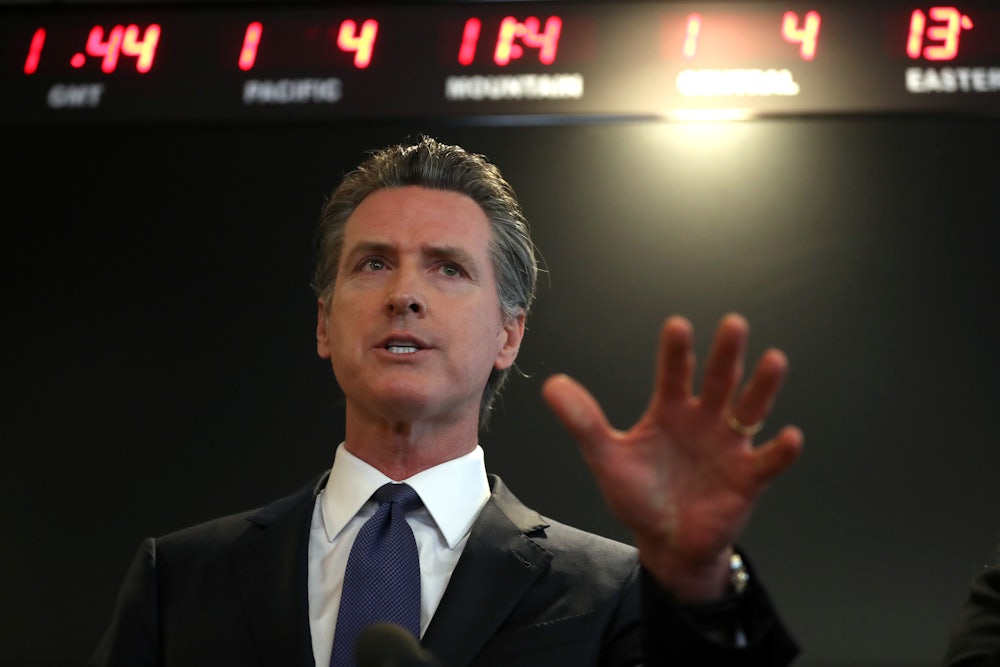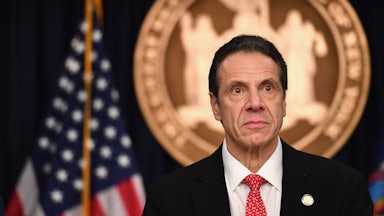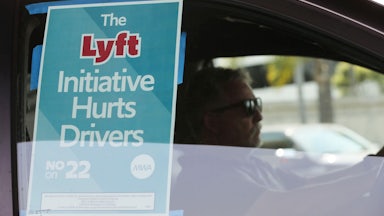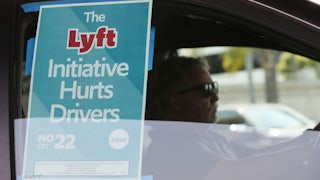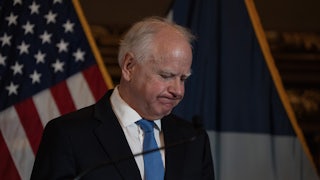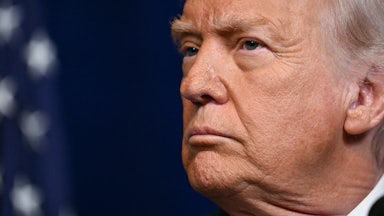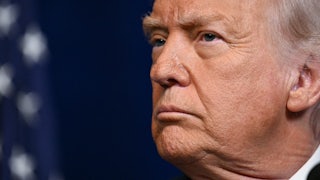Few figures in recent American history have found a smoother path to power than California Governor Gavin Newsom. His father, a state appeals judge appointed during Jerry Brown’s first stint as governor, had enviably close ties to the Getty dynasty: He administered the family trust and helped to deliver the ransom money that freed John Paul Getty III. Newsom grew up an awkward and lonely kid, and the Gettys took him in as a sort of auxiliary son. Those close connections eventually developed into tight relationships with the rest of San Francisco’s so-called “first families,” putting Newsom on the path to elevation and influence.
His “easy familiarity with San Francisco’s upper crust,” as The San Francisco Chronicle put it at the time, was part of the reason that then–San Francisco Mayor Willie Brown appointed Newsom to his first public office, an open County Supervisor seat. Bay Area society families like the Pritzkers and Fishers backed him as he defended that seat and began his march to the governor’s office. As the Los Angeles Times reported in 2018, these elite connections furnished “crucial support to a political newcomer in the years before his campaign accounts piled high with cash from labor unions, Hollywood honchos, tech billionaires and donors up and down the state.”
Newsom is an unabashed idolizer of Robert F. Kennedy; his political career has resembled a long exercise in recreating that special Kennedy mix of aristocratic bearing and apparent devotion to the needs and hopes of regular people. It has always been a something of a halting effort, however, and now one fancy dinner may end up being the undoing of Newsom’s long and carefully managed rise.
As of Tuesday, a push to generate a recall election to remove Newsom from office has gathered 1,308,000 signatures, according to Randy Economy, a senior adviser to the effort and former radio L.A.-area radio host. This is the sixth recall push launched against Newsom since he took office in 2018. All of these sputtered out without coming close to the 1.5 million signatures needed to trigger a recall election under California’s constitution, which allows a recall if a specific number of registered voters (in this case, 12 percent of the electorate in the last gubernatorial election) sign a petition demanding one. In recall efforts past, many of the gathered signatures get thrown out after they’re submitted for verification by the secretary of state—they might represent someone who isn’t registered to vote, or who signed twice—and so many observers have estimated that a recall effort against Newsom would need to gather around two million signatures by March 17, a very tall order.
But when Newsom was spotted in November, maskless and eating at Thomas Keller’s French Laundry in Napa, the photos of the event seemed to offer a perfect visual encapsulation of what many Californians have always latently distrusted about Newsom: Here he was, eating in an enclosed space with Dustin Corcoran and Janice Norman—respectively the CEO and the lobbyist for the California Medical Association, an organization that in theory should have been helping to lead the charge to follow Newsom’s orders and enjoinments to stay home and avoid public gatherings. The occasion for the French Laundry gathering was the birthday party for yet another lobbyist, Jason Kinney—a Newsom confidant who had made a very of-the-moment California career lobbying for companies such as Weedmaps, which sit at the intersection of the tech and marijuana industries. In that moment, Newsom became a national symbol of the hypocrisy of a political and economic elite serenely weathering a seemingly endless lockdown in comfort, while the regular Californians suffer in confusion over when and how the state would emerge from the crisis.
Consequently, the signature-gathering efforts began to accelerate. By January, rural California had been blanketed in yellow “Recall Gavin Newsom” signs, and volunteers were fanning out to grocery stores and sending out mail-in signature forms. I was in the northern and generally conservative town of Redding on January 6, when supporters of President Donald Trump were taking to street corners across the state, and was surprised to hear a man collecting signatures tell me he wasn’t following the siege of the Capitol that day. “The recall is where the energy is now,” he said. “We’re coming for them.”
California Democrats were caught by surprise: The recall effort had not raised the sort of money that is traditionally required to finance a major statewide signature-gathering effort (as of last week, the campaign had only netted about $2.4 million), and campaigners have been slowed by a lack of foot traffic and public gatherings. But of the roughly 400,000 signatures that have been officially submitted to the secretary of state’s office thus far, only about 15 percent appear to have been rejected. That’s a very low rate comparatively; should it hold, it will make a recall a very likely prospect.
In response, California Democrats attempted to explicitly link the recall effort to Trump’s inflammatory rhetoric and the siege of the U.S. Capitol it inspired. State Democratic Chair Rusty Hicks held a press conference, in which he called the recall a “California Coup” and characterized those behind the effort as conspiracy theorists and white supremacists. This proved to be a huge mistake: When reporters asked him for evidence to support his claims, he could only offer a wan promise to “follow up … with some specifics.” The incident generated widespread backlash, even among liberal commentators, who rightly pointed out that a volunteer-led effort to use a constitutional mechanism to remove a governor was hardly the same thing as a violent coup.
These miscalculations put recall proponents in the catbird seat: With momentum and publicity on their side, they’ve been able to argue successfully that they represent a broad-based movement. Randy Economy told The New Republic that 300,000 Democrats have signed on to the effort. “It’s not a Republican thing,” he said. “There aren’t enough Republicans in California to make this happen.”
Economy’s claims are likely a bit of bluster: The recall is still very much a Republican project and is suddenly drawing support from the mainstream of California Republican politics. But Newsom has now found himself in the middle of a swirl of popular anger that’s no longer just coming from the rural fringe and emaciated Republican Party that has been so easily brushed aside in recent California elections. A suddenly renewed stay-at-home order angered many and was openly defied across much of the state, where militias have warned officials not to try to shut businesses that have stayed open in defiance of public health orders. Newsom’s subsequent lifting of those orders angered many others, and he has exposed himself to charges that he was only opening up the state to defuse recall efforts. It hardly helped that he initially refused to release the data on hospitalization rates that he and his advisers used to justify the loosened restrictions. Only 31 percent of voters now think Newsom has done a good job handling the Covid-19 crisis, down from nearly two-thirds in September. Polls released today have shown a precipitous drop in his approval ratings, which have now fallen below 50 percent for the first time.
“This guy’s worst problems, even including politically, come from the fact that they just don’t communicate well and they certainly don’t take the time to communicate in a way that introduces people to something, gives them more information, and then you effectuate it,” Karen Smith, a former director of the California Department of Public Health, told the Los Angeles Times recently. “It’s crazy, because that’s sort of basic and how you talk to people when you want to get them on your side.”
This crisis of leadership has much to do with the way Newsom has always presented himself: the slick and connected figure whose governing philosophy has always been above all that Gavin Knows Best. This shtick may be uniquely ill suited to this moment.
Meanwhile, former San Diego Mayor Kevin Faulconer announced yesterday that he’s officially intending to run if the signature-gathering efforts are able to force a recall election, which would probably take place sometime in midsummer. All indications are still that Newsom would easily beat Faulconer in a traditional head-to-head matchup, in a state where Democrats outnumber Republicans two to one. But the recall election poses a two-part question: Voters are first asked if they want to recall the governor. If 50 percent or more vote yes, then the second question on the ballot, which asks voters to choose Newsom’s replacement, comes into play. As happened in the last California recall, when Arnold Schwarzenegger won the statehouse, this could produce surprising candidates and odd coalitions that break the traditional molds of California politics, especially since Democrats may be reluctant to put up their own alternative to Newsom and weaken his position.
Californians are leaving the state at some of the highest rates in its history, and dissatisfaction over home prices, the power of tech interests, and the inequality that has seen homeless camps spring up seemingly in every neighborhood in the state could produce some unexpected political results. The billionaire investor and former Facebook executive Chamath Palihapitya has already donated $100,000 to the recall effort and seems to be preparing to run on a sort of techno-libertarian populist platform: “Wet your beak California,” he tweeted last week. “[Zero percent] taxes, best paid teachers in the country and a bonanza of climate friendly jobs.” Trump may be gone, but the populist ferment across the political spectrum that helped drive his rise is still with us. California may be about to show us what kind of unexpected forms it may take.
